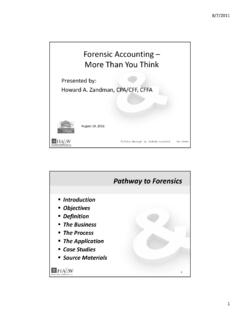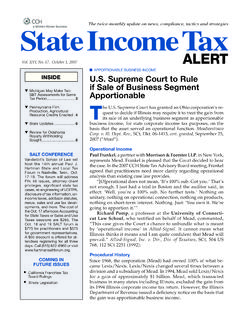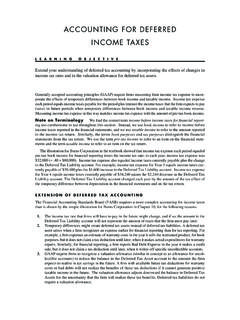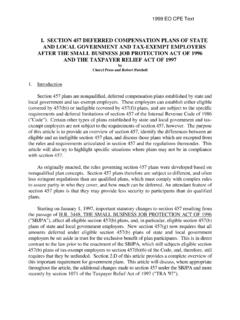Transcription of Non-Profi t Organizations Have Few Options for Deferred ...
1 September October 2007. Non-Profit Organizations have Few Options for Deferred Compensation By William L. MacDonald and Bruce Knox William MacDonald and Bruce Knox explain how the new Regulations under Code Sec. 409A impose restrictions on non-profit Organizations in compensating their executive level employees. T. ax-exempt Organizations are subject to more services requirement in Code Sec. 457(f), including stringent IRS rules than their for-profit coun- eligible Deferred compensation plans under Code terparts in terms of how they can provide Sec. 457(b), tax-sheltered annuity plans under Code nonqualified Deferred compensation plans for highly Sec. 403(b), and qualified retirement plans under paid employees. Code Sec. 401(a). However, there are limits on the Non-profit Organizations should analyze their amounts that can be Deferred under these plans. Deferred compensation arrangements to ensure that such arrangements comply with the restrictive tax Deferred Compensation requirements of Code Sec.
2 457. Code Sec. 457(f). generally provides that in order to defer an em- Alternatives ployee's compensation to a future calendar year, the Fortunately, alternatives are available for tax-exempt payment of that compensation must be contingent on Organizations that seek to set up such plans for their the employee performing substantial services for the highly compensated employees and contractors. By employer through a date in that future calendar year. subjecting employer-paid, tax- Deferred compensa- If such a contingency is not present, the compensa- tion to risk of forfeiture or by paying the required tion will be taxed in the first calendar year in which taxes, tax-exempt Organizations can develop work- that contingency is no longer present. For example, if able alternatives for funding nonqualified Deferred an organization establishes a Deferred compensation compensation plans. arrangement that provides an employee with $50,000 Nonqualified Deferred compensation plans in a year for the following two calendar years, the em- tax-exempt Organizations , unlike those in for-profit ployee generally will be taxed on the $100,000 in Organizations , are subject to Code Sec.
3 457. Two the calendar year that the arrangement is established types of Deferred compensation plans exist under if the payment of that $100,000 is not contingent on Code Sec. 457: eligible and ineligible. Under Code the employee performing substantial services for the Sec. 457, contributions to an eligible plan are lim- organization in the two future calendar years. Cer- ited to the lesser of $15,500 or 100 percent of an tain arrangements are exempt from the substantial employee's annual compensation. In general, it is financially advantageous to highly compensated William L. MacDonald is Chairman, President & Chief employees to maximize contributions to 403(b) and Executive Officer of Retirement Capital Group, Inc. 401(k) plans. However, maximizing these contribu- Bruce Knox is President of Retirement Capital Group, tions can be accomplished only at the expense of the Executive Benefits Practice. Code Sec. 457 plan.. 2007 MacDonald JOURNAL OF RETIREMENT PLANNING 23.
4 Non-Profit Organizations have Few Options for Deferred Compensation Therefore, employees who choose to maximize forfeiture. Furthermore, tax-exempt Organizations contributions to Code Sec. 403(b), 457(b), and 401(k) traditionally have provided portable retirement plans can participate only in an ineligible Code Sec. benefits to highly compensated employees. Hence, 457 plan. Many Organizations are taking advantage of the dilemma in developing nonqualified Deferred the ability to maximize their contributions in both the compensation plans for such employees in tax- 401(k) or 403(b) and a 457 plan. This coordination al- exempt Organizations is how to achieve tax deferral lows a person whose employer has a 401(k) or 403(b) for vested nonqualified benefits. plan and a 457 plan to defer the maximum contribu- There is no official guidance on what constitutes sub- tion into two plans instead of being subject to a single stantial risk of forfeiture beyond making the payment limit amount.
5 Thus, a participant can contribute the of Deferred compensation conditional on the future maximum $15,500 for 2007 into their 401(k) and also performance of substantial services. Because of a lack the maximum $15,500 into their 457(b). If that person of official guidance, the interpretation of substantial risk is over age 50, they can also contribute the additional of forfeiture varies, and many look to Code Sec. 83, catch-up amount into each plan meaning an ad- which also refers to substantial risk of forfeiture. ditional $5,000 into the 401(k) and another $5,000 Generally, Deferred compensation that is based into their 457(b). With an ineligible plan, Deferred either on continued employment for a specified pe- compensation contributions have no limits. However, riod or on the occurrence of a specific event, such they are taxed in the current year unless the plan is as retirement, is considered subject to risk of forfei- subject to a substantial risk of forfeiture.
6 Ture. Thus, after Deferred compensation is vested, it It is important to understand why tax-exempt is no longer considered subject to substantial risk of Organizations are subject to Code Sec. 457 for forfeiture. If Deferred compensation is vested upon both non-elective (employer-paid) and voluntary the occurrence of a specific event, such as eligibility (employee-paid) Deferred compensation plans. for retirement, then eligibility for retirement triggers For-profit Organizations pay taxes on the Deferred vesting and taxation of the benefit at that time, even compensation until it is paid to employees; tax- if the employee does not retire. exempt Organizations , by definition, are not subject to this taxation. In addition, the growth of assets held Is There an Alternative by tax-exempt Organizations to fund nonqualified plans is non-taxable because the organization itself to Code Sec. 457(f)? is exempt from taxes. By subjecting nonqualified Yes, one alternative is an Insured Security Option Deferred compensation plans to strict forfeiture Plan (ISOP ).
7 ISOP is a wealth accumulation benefit requirements, the IRS intends to discourage the program designed for the highly compensated at non- provision of tax-sheltered Deferred compensation profit Organizations . The purpose of the ISOP is to to highly paid employees at the expense of all other provide a tax-advantaged savings and investment ve- employees in the tax-exempt organization . hicle without the annual contribution limits imposed on qualified plans, such as the Code Sec. 401(k) and Code Sec. 457 Guidelines 403(b) limits, or the restrictions of Code Sec. 457. Deferred compensation plans that are subject to The 3 Phases of Your Money Code Sec. 457(f) include defined contribution plans and benefits provided under individual and group To see the advantages of the ISOP , it is important to agreements. Early retirement incentives can also be think of your money as having three distinct phases subject to Code Sec. 457(f). (see Chart I). In planning for retirement income, one should focus on the three phases of retirement income Substantial Risk of Forfeiture planning: the contribution phase, the accumulation phase, and the distribution phase.
8 Understanding As mentioned earlier, ineligible Code Sec. 457(f) these phases will provide a better appreciation of plans allow for tax- Deferred compensation only the ISOP 's design. when the Deferred compensation is subject to During the contribution phase, a portion of income substantial risk of forfeiture. Voluntary Deferred is set aside for use in future years. We have always compensation plans typically are not subject to been told that pre-tax deferral is better than after- 24 2007 CCH. All Rights Reserved. September October 2007. tax, but is that really true? By deferring pre-tax, we income during retirement and is safe from creditors of accept that all distributions at retirement will be taxed the sponsoring organization . The important thing to as ordinary income. remember is, It's not how much you make, but how The next phase is the accumulation or invest- much you keep. The distribution phase could be the ment phase. This is when our money grows.
9 We have most important phase of your retirement planning. No always been told not to put all of our eggs in one bas- one knows what income tax rates will be when you ket during this phase. Truly, investment diversification retire (Chart III). Going from a 35 percent tax bracket is important. However, of greater importance is the to a 50 percent tax bracket reduces your retirement non-taxable, Deferred growth of the money. income by approximately 25 percent. The ISOP dis- The final phase is the distribution phase. In this tributes income at retirement without taxation, thus phase, the money is taxed at the time of distribution. taking the future tax risk out of the equation. Based This phase is of paramount importance. on the history of top income tax rates (Chart III), how likely is it they will Chart I continue to decrease? Contribution Phase Accumulation Phase Distribution Phase The ISOP provides the Pre-tax, after-tax, or both? ROI (Return on Invest- Typically three buckets are power of pre-tax savings Qualified Plans have limits.)
10 Ment) directly impacts available during distribution. without the contribution retirement lifestyle. Taxable as regular income We are told that pre-tax is limits or age restrictions better, but this is not always Modern Portfolio Theory Taxable as capital gains of qualified plans. To get the case. Real estate invest- states that diversification is key. Non-taxable the maximum value from ing, for example, is done with after-tax dollars and Mutual fund investing is Just as you diversify during retirement accumula- accumulates tax- Deferred . a common form of diver- accumulation, you should diversify during distribution. tion, participants should The ISOP is designed for sifying. first maximize their pre- participant control and Objective is tax- Deferred The ISOP is designed to creditor protection. accumulation. payout in a tax-advantaged tax contributions into manner. their 403(b), 457(b), and 401(k) plans. What is the ISOP ? How the ISOP Works What sets the ISOP apart from traditional Deferred compensation plans as well as qualified plans is The ISOP achieves its tax-advantaged status as a the way participants are taxed (see Chart II).



![Lease Accounting CPE slides [Read-Only]](/cache/preview/b/e/e/e/3/4/1/5/thumb-beee3415077ca108d94220e1fd63be5b.jpg)










